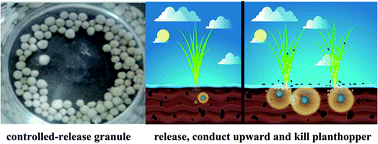Development and evaluation of pymetrozine controlled-release formulation to control paddy planthopper
Abstract
Continuous outbreaks of rice planthoppers in rice-growing regions in China indicates the importance of redesigning several planthopper management programs. Chemical control remains the main strategy for planthopper control in China and other subtropical and temperate regions. Most common chemical insecticides are emulsifiable concentrates, suspension concentrates, soluble concentrates, and wettable powders. These insecticides are applied by dusting or spraying using simple equipment. The active ingredient, with short effectiveness time, is degraded rapidly in natural paddy ecosystems. Thus, repeated pesticide applications are required to control rice planthoppers. Altering the short-term effect formulation of pesticides to a long-acting formulation may be an alternative solution. A pymetrozine controlled-release granule (CRG; 1%) was developed by loading the pesticide on bentonite and coating the solid pesticide with resin. Analysis of pymetrozine release indicated that the 1% pymetrozine CRG release was more than 80% for 60 days. In the field trial screening, the 1% pymetrozine CRG showed a controlled effect of 61.96–78.87% at 48 days after CGR application. Application of 1% pymetrozine CRG at the recommended dosage and 1.5 times the recommended dosage resulted in terminal residues on brown rice below the maximum residue limit (0.1 mg kg−1) of China and Japan. Moreover, the pesticide granules showed low toxicity against all tested beneficial organisms in the environment. Pymetrozine CRG (1%) showed good controlled release and efficacy for controlling paddy planthoppers. The compound exhibited a low terminal residue and low toxicity against all tested beneficial organisms. Pymetrozine CRG (1%) showed great potential for field applications to control paddy planthoppers, because it overcame the rapid loss of biological function during treatment.



 Please wait while we load your content...
Please wait while we load your content...